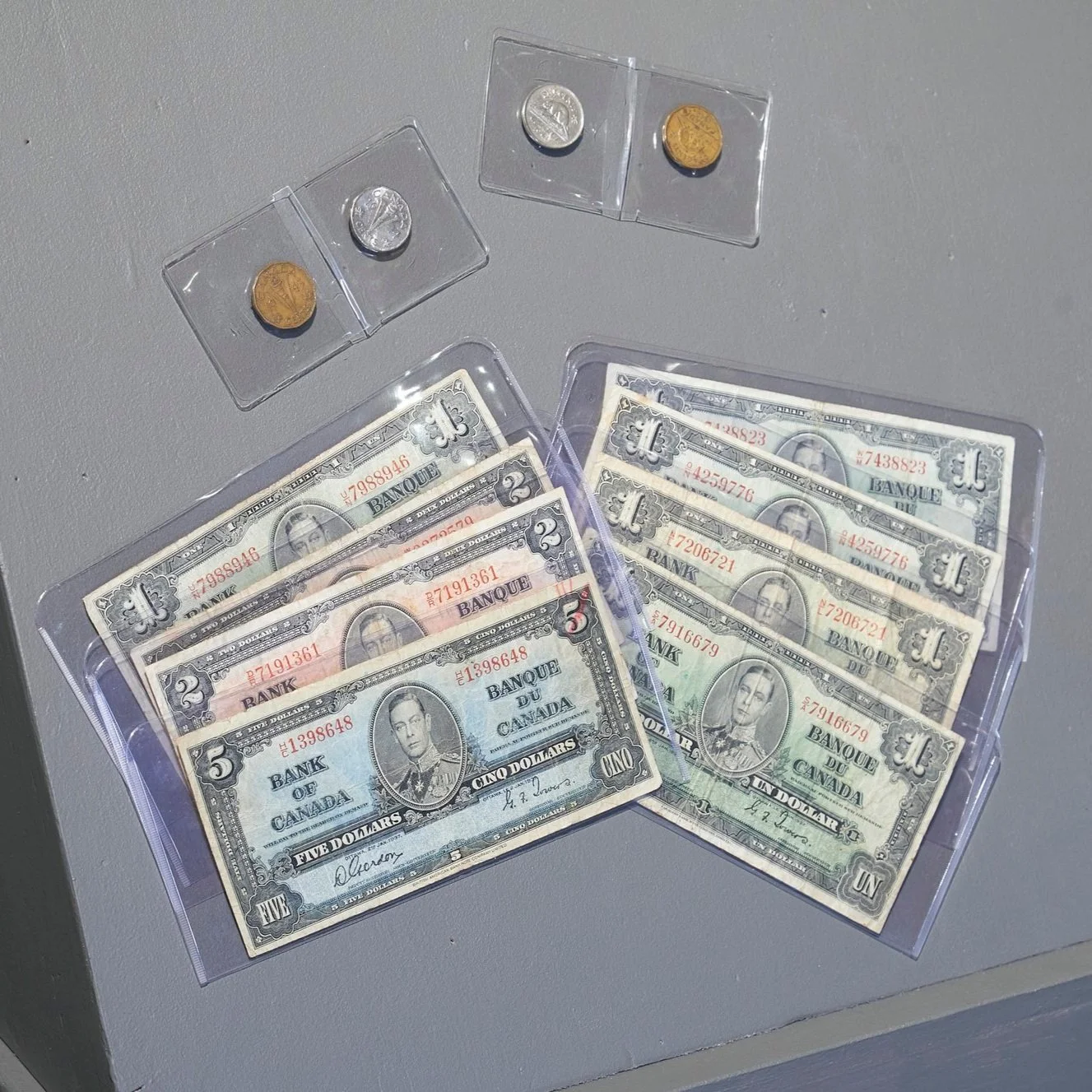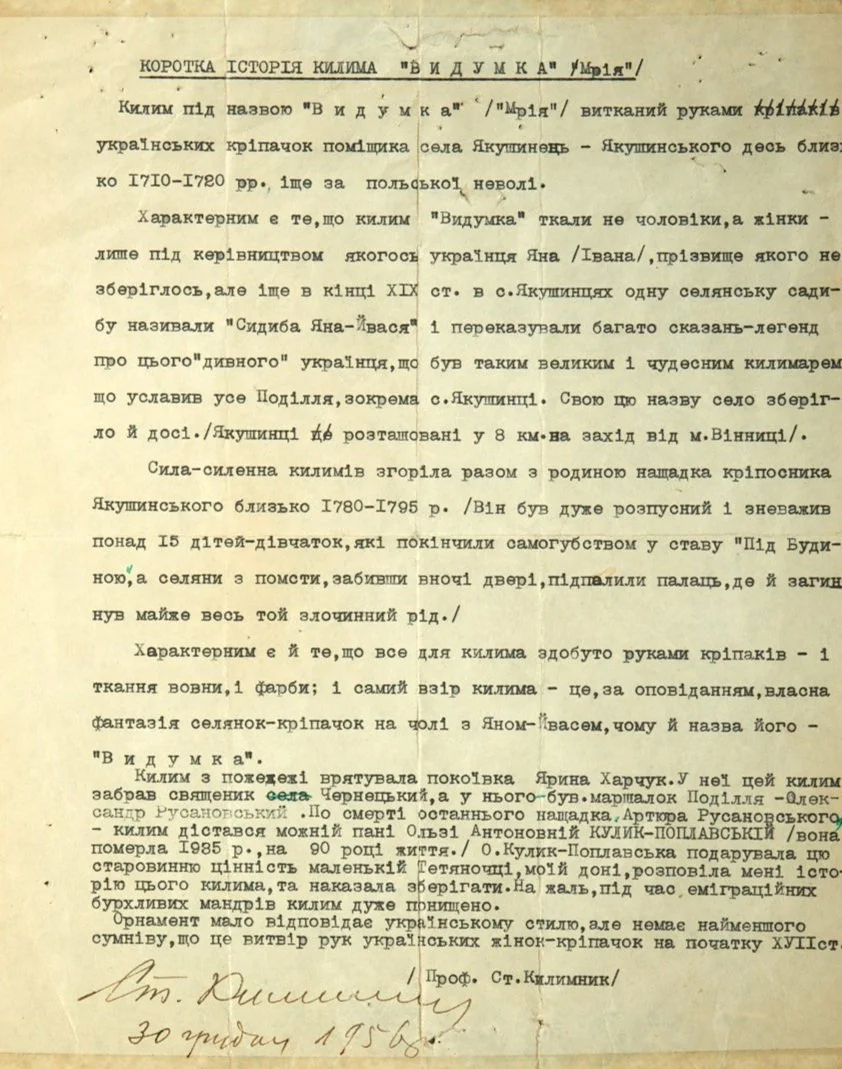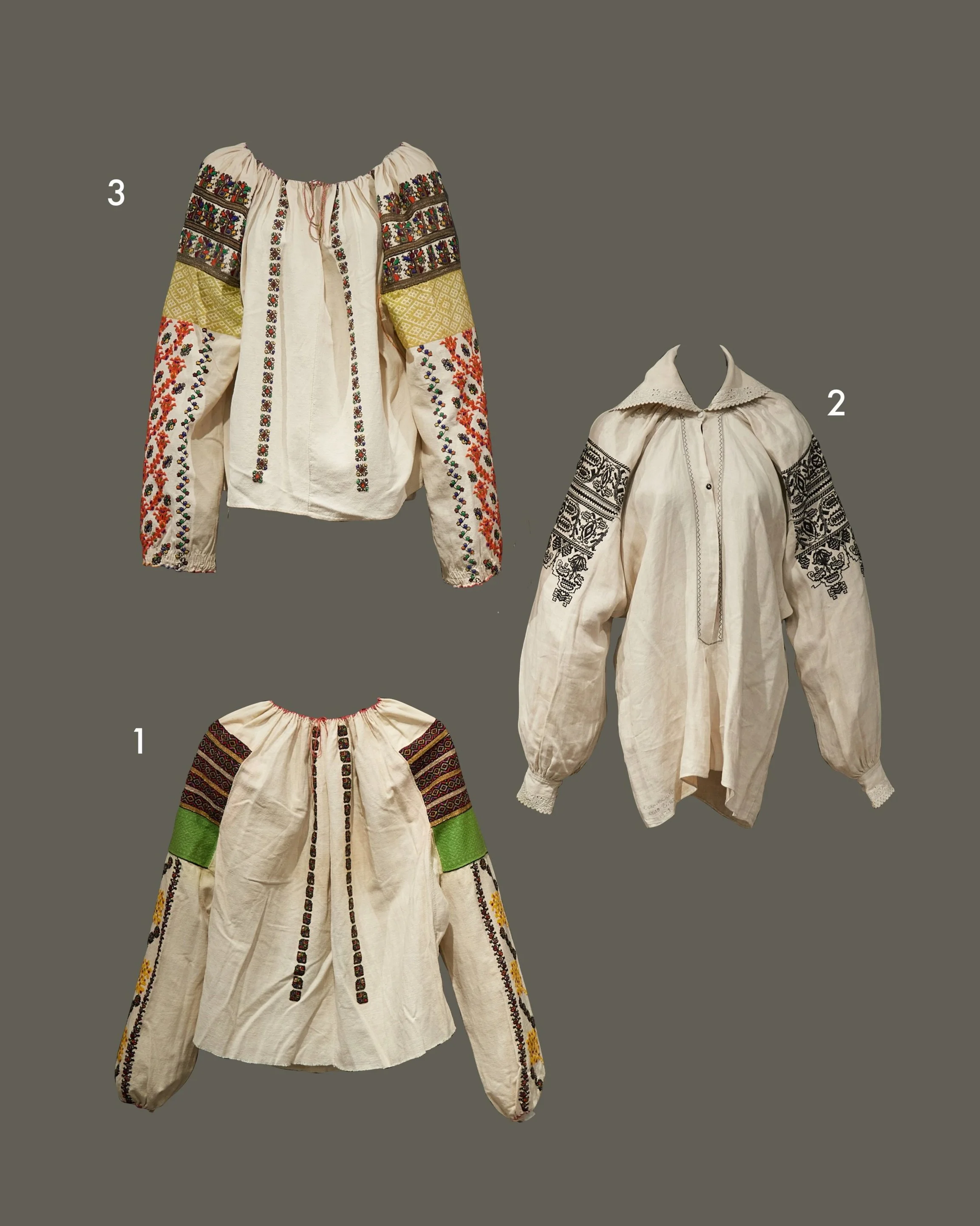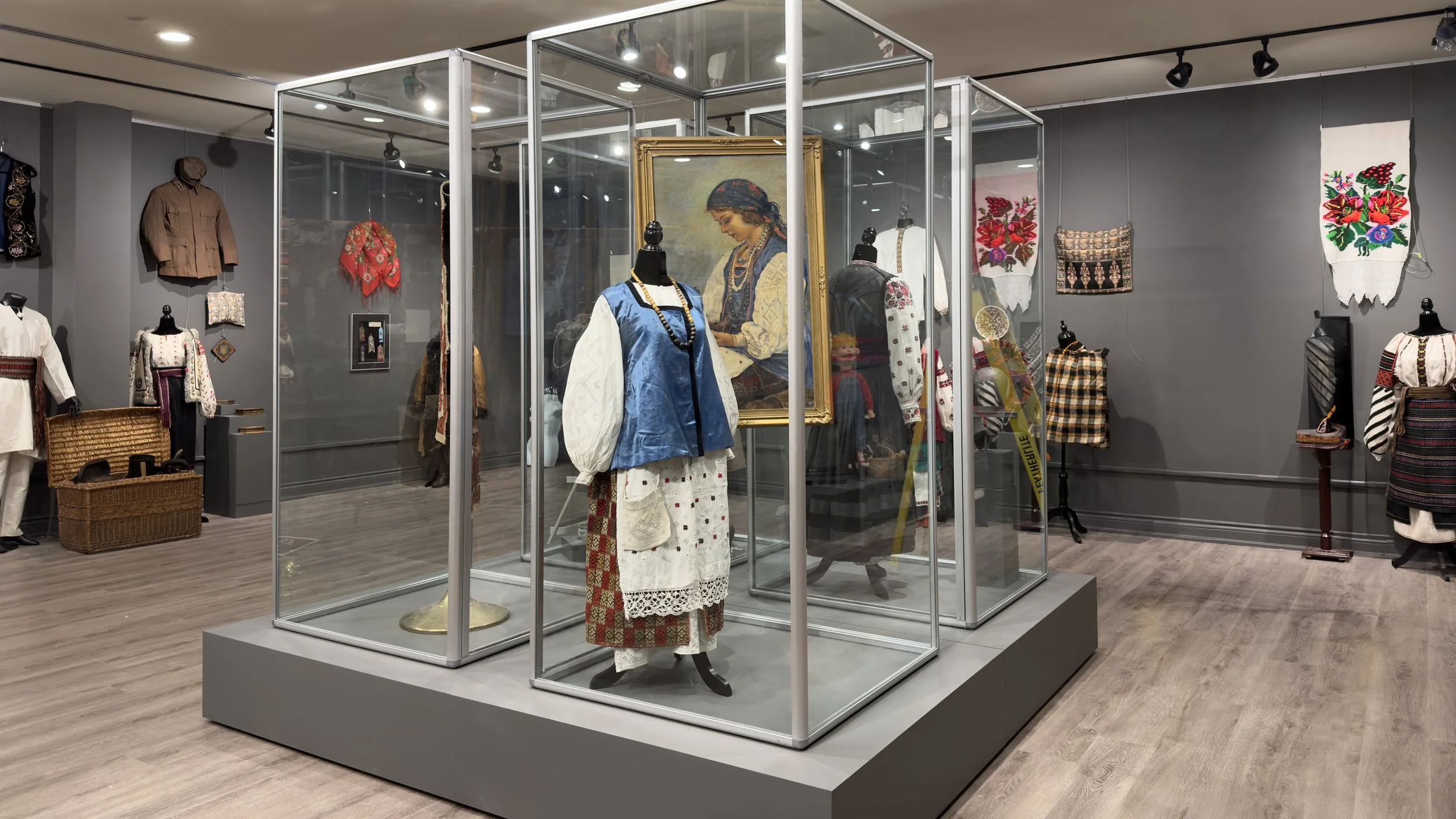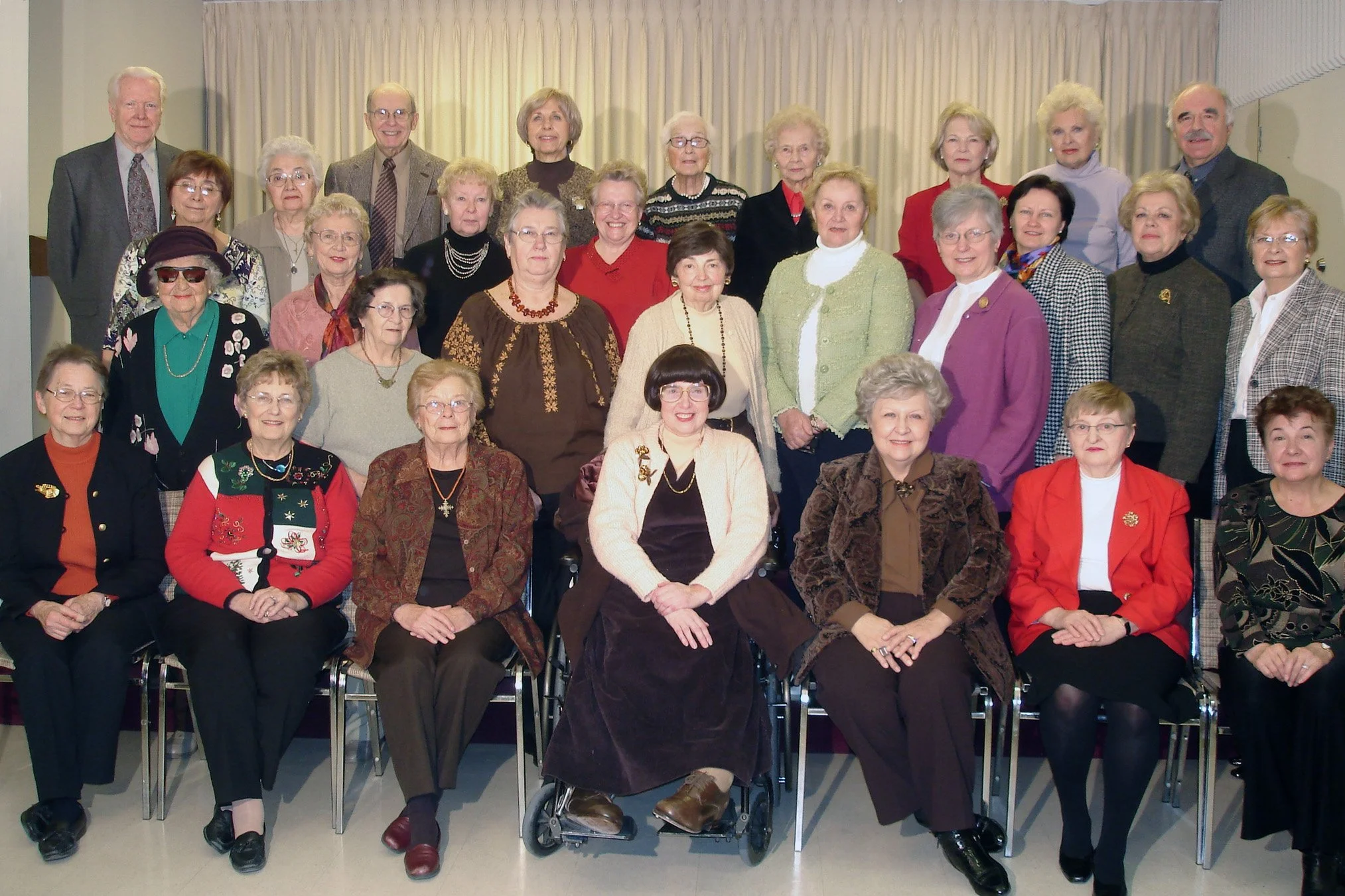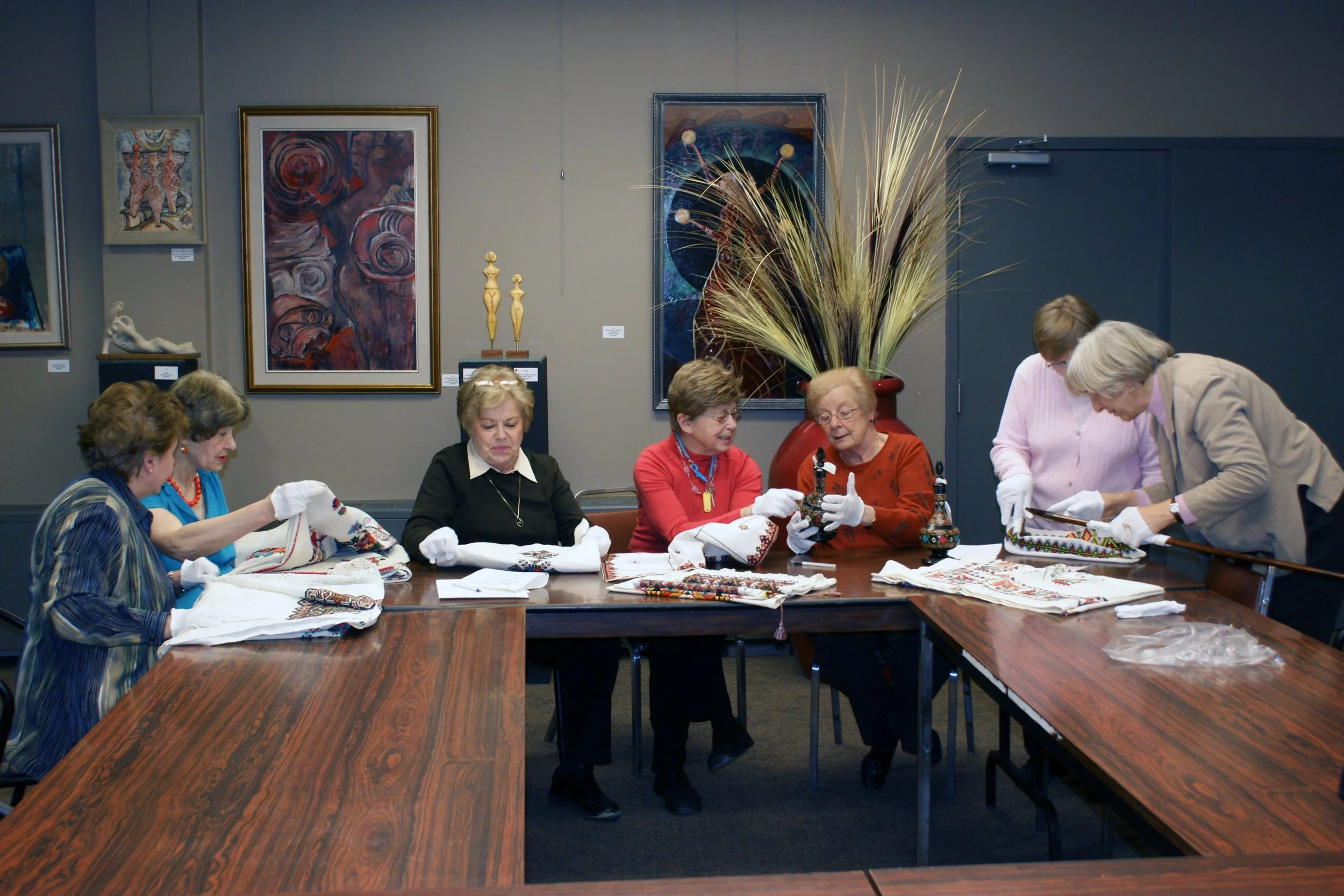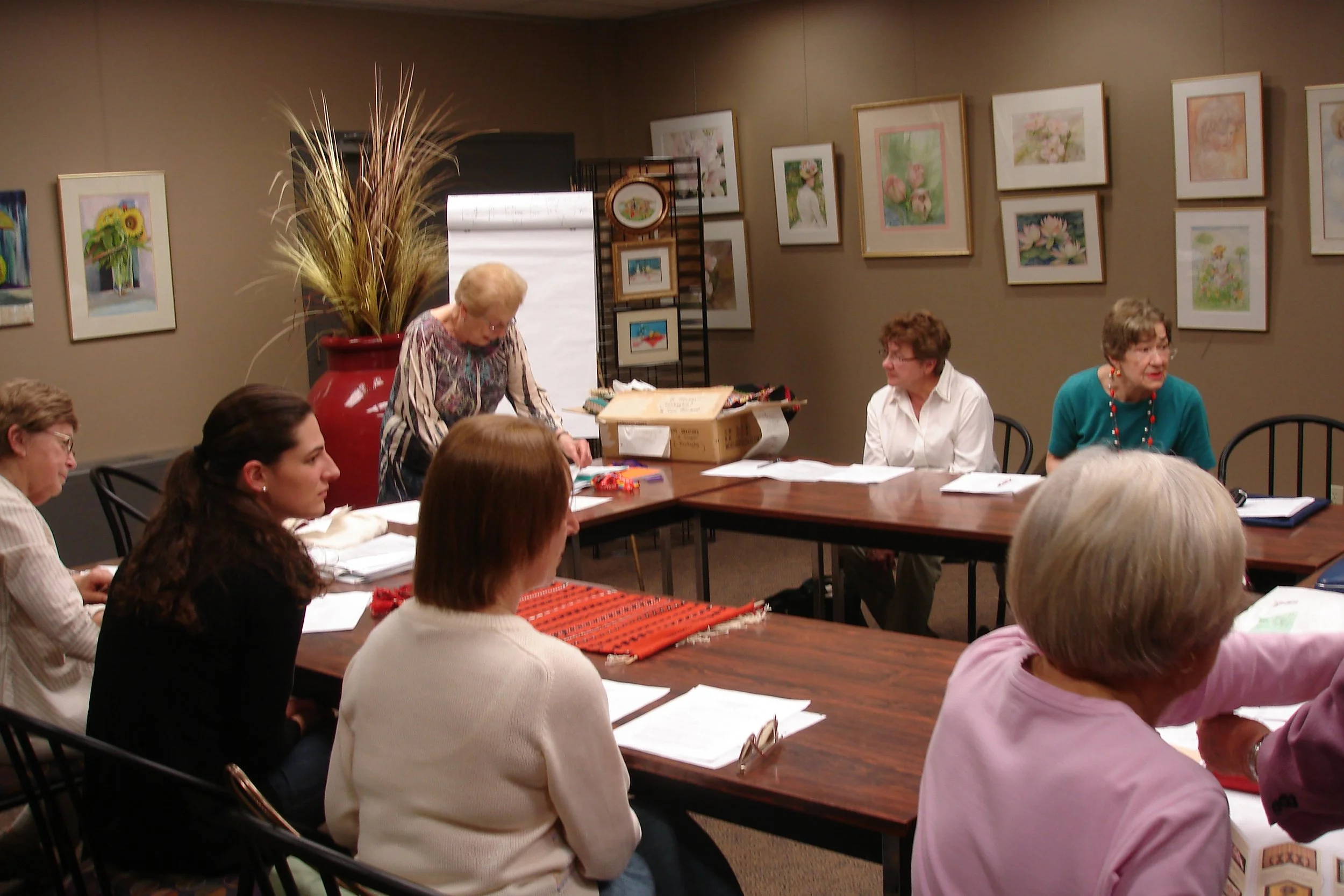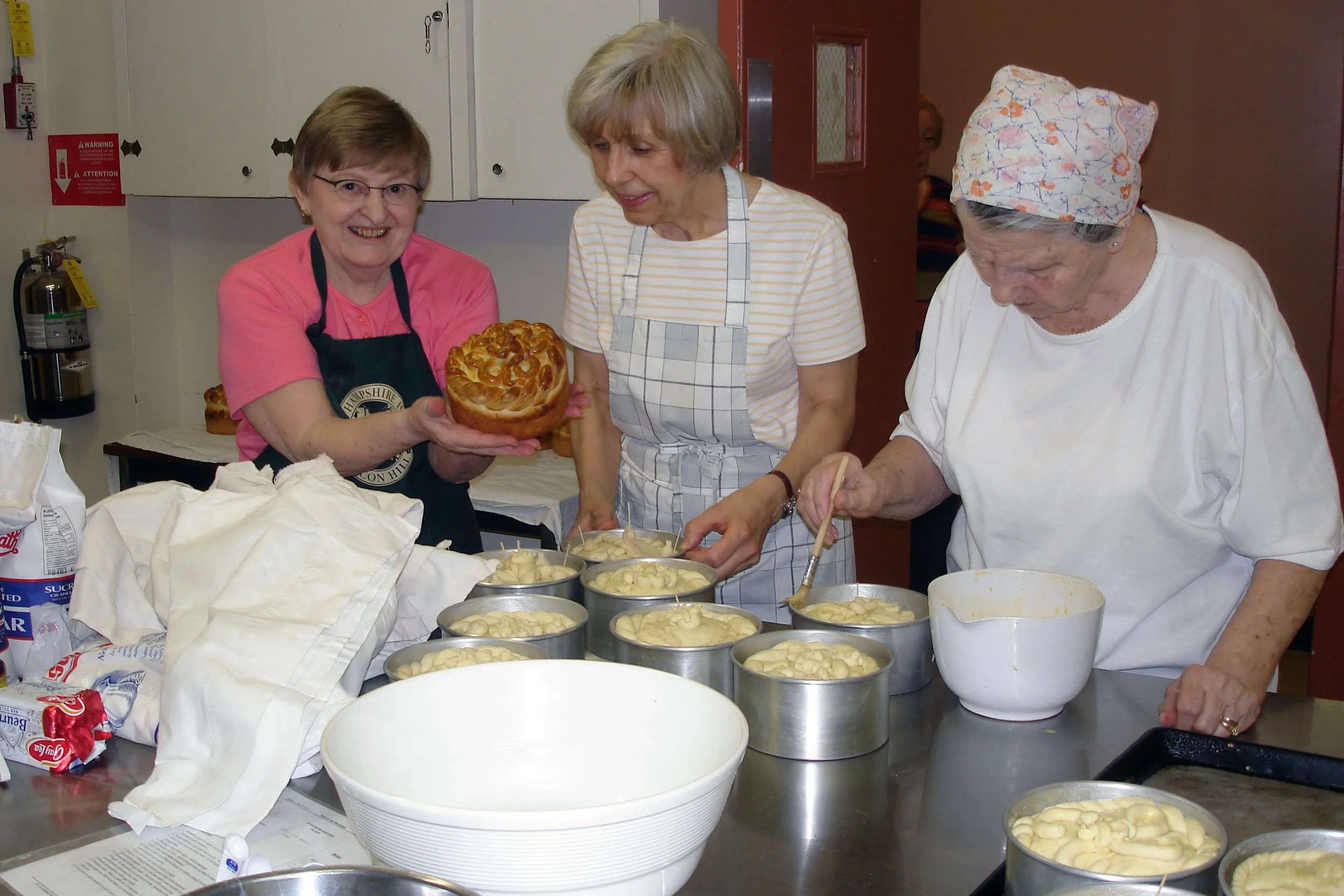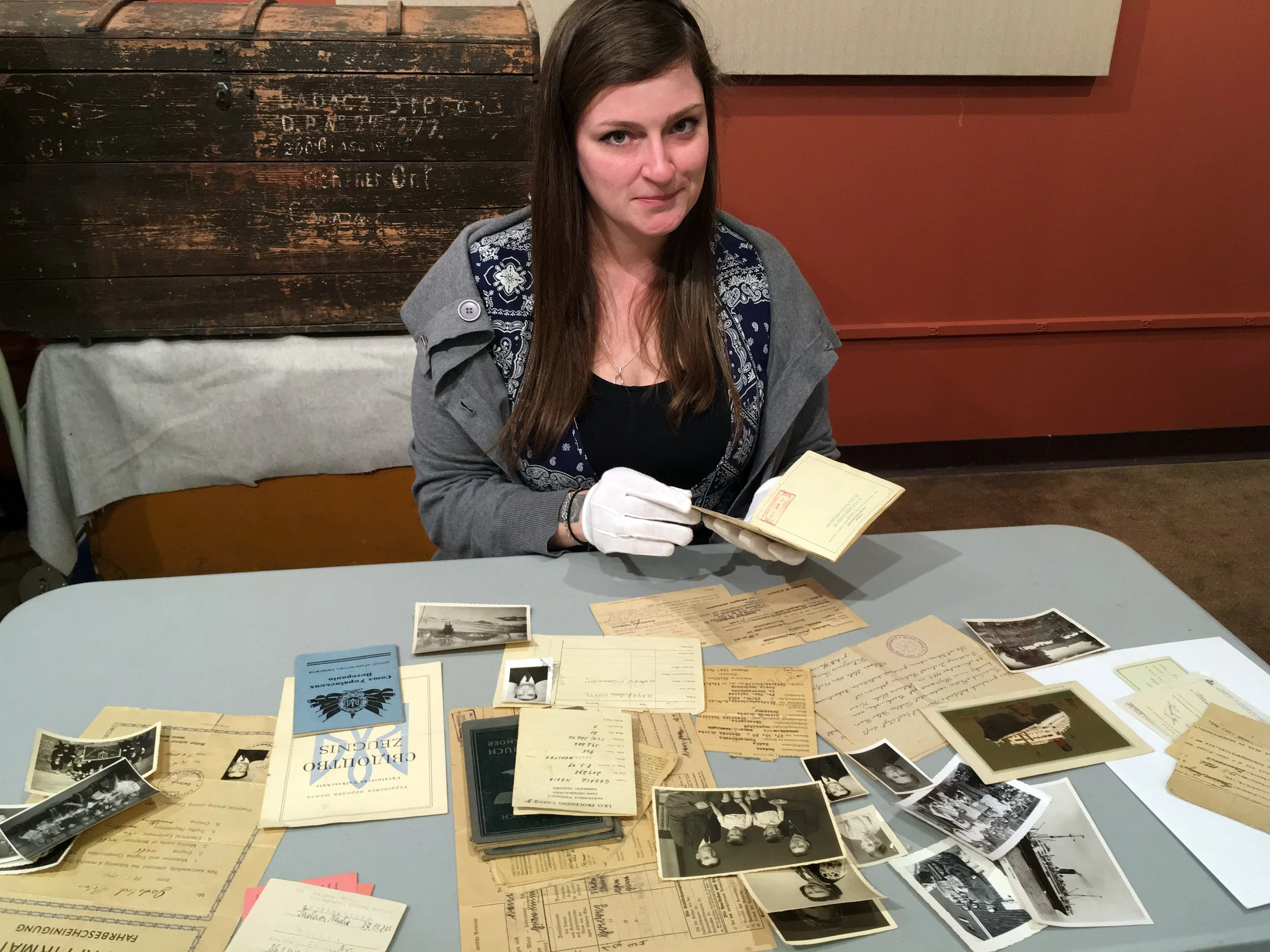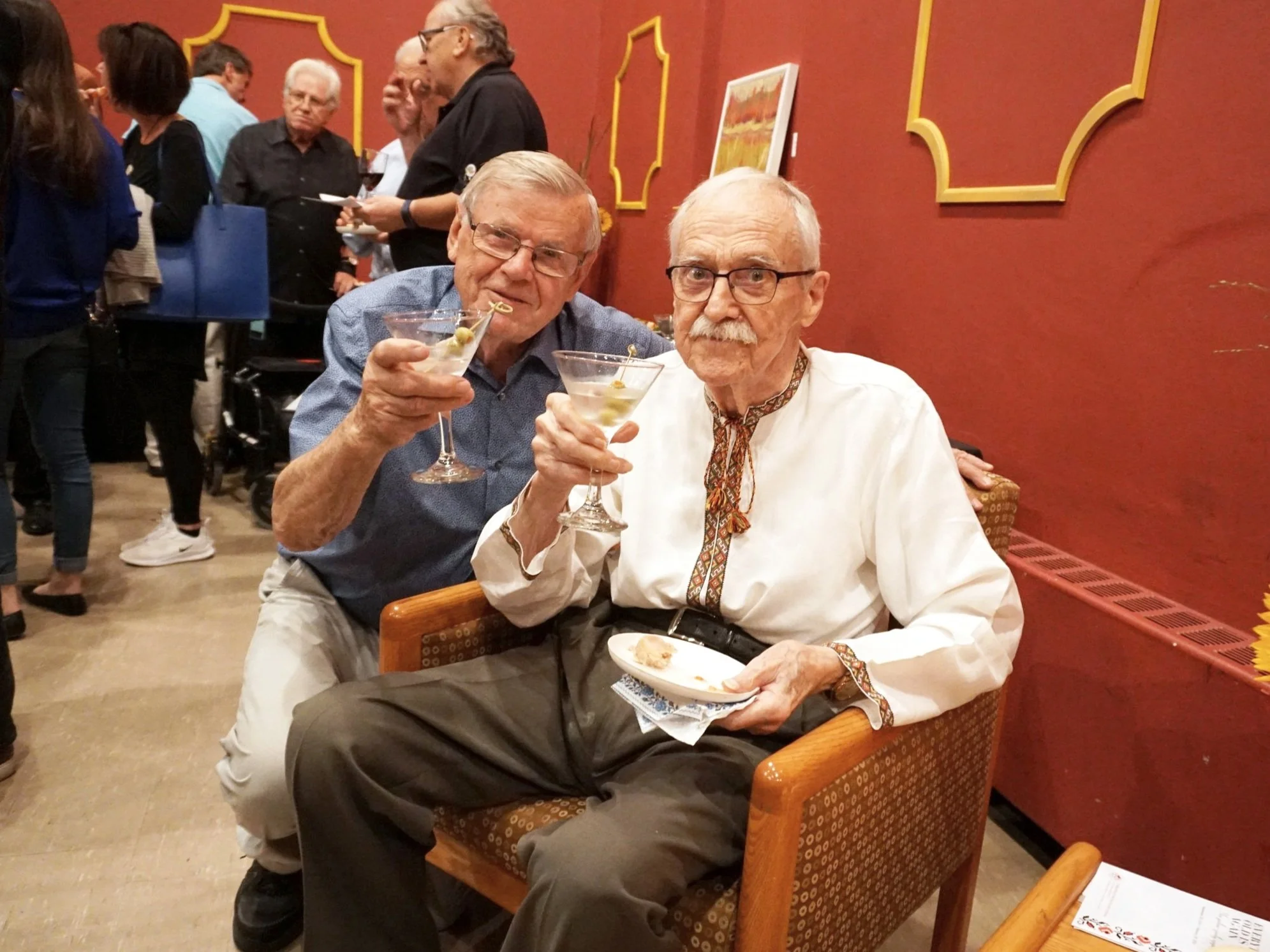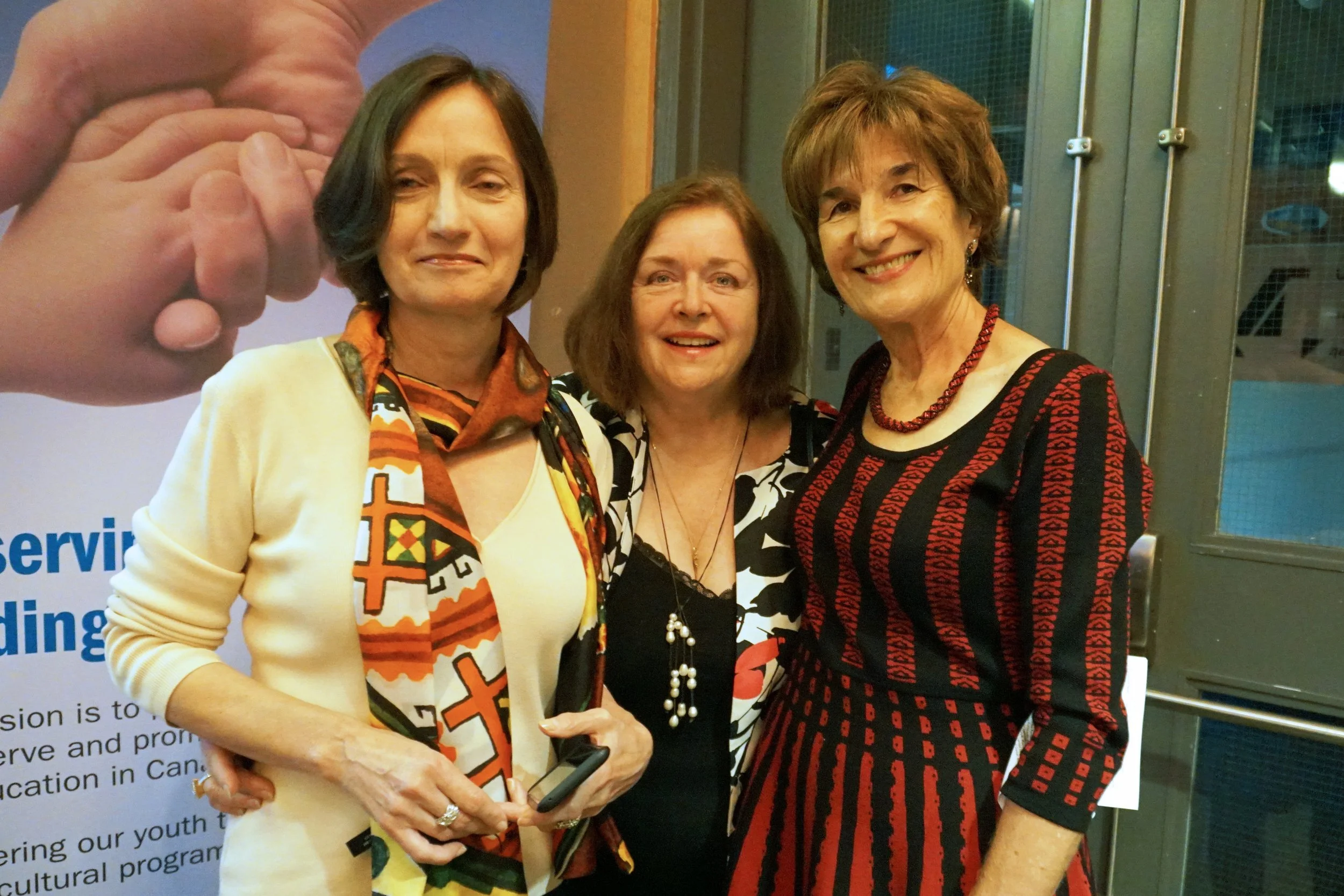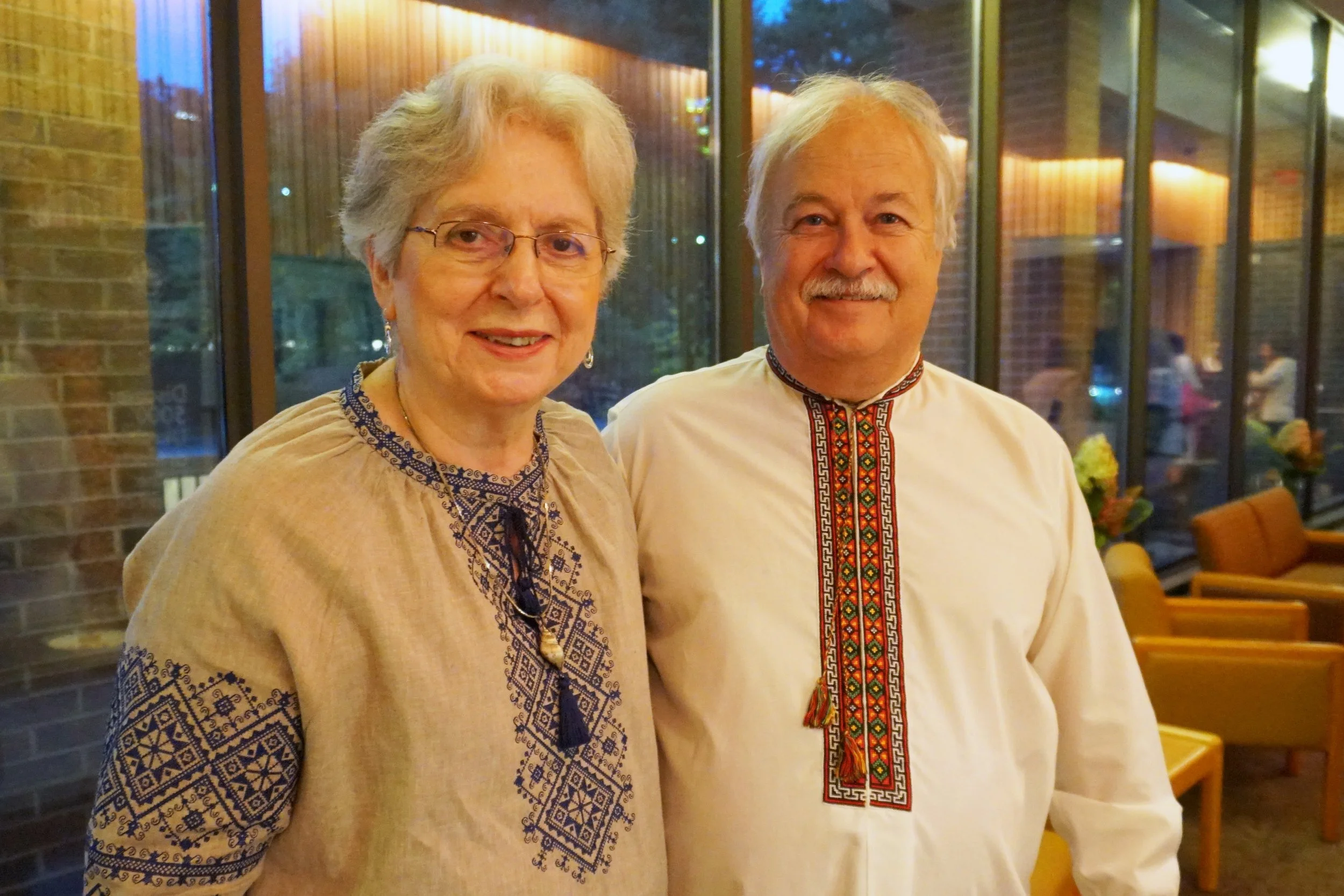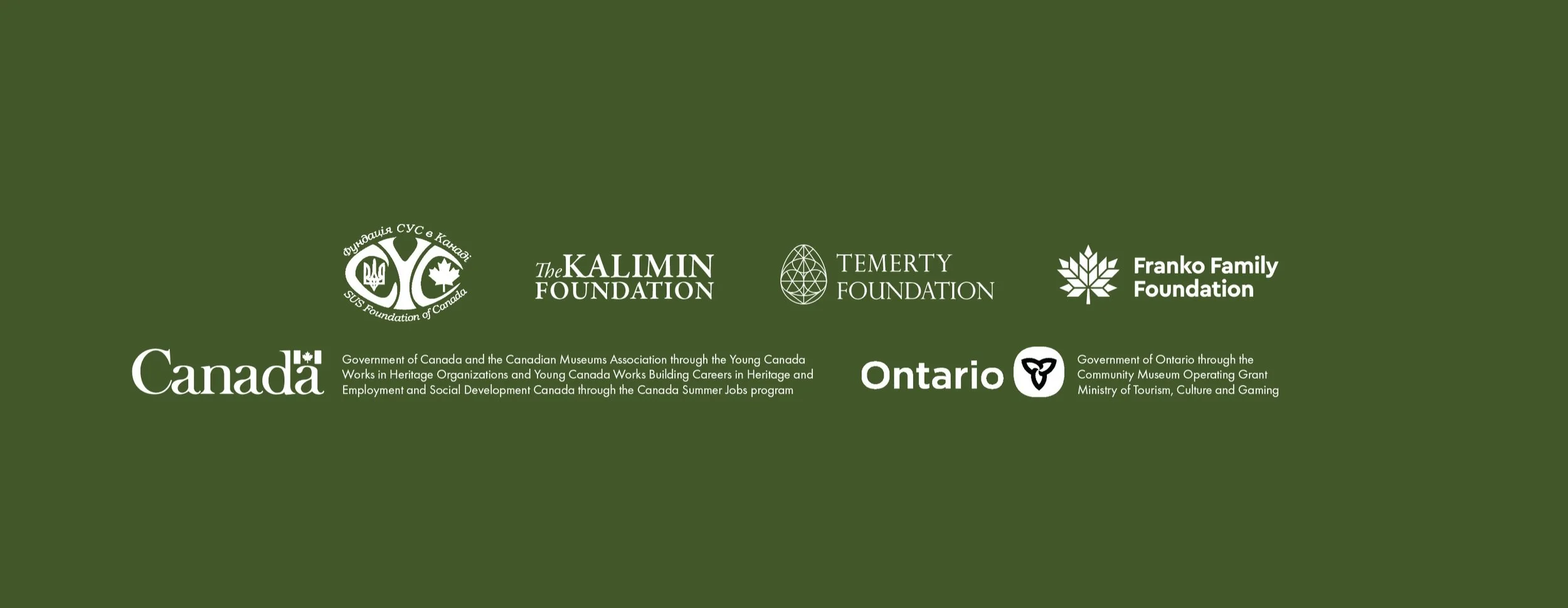
The provenance of an artifact in a museum’s collection breathes life into the item displayed. On this, the 80th anniversary of the founding of the Ukrainian Museum of Canada - Ontario Branch, care has been taken to share the stories of a selection of our artifacts. We honour the dedication of creators, collectors, and caregivers who have joined forces over decades to make this experience a reality, and we invite all who visit, to share in our celebration.
Sleeve from a child’s shirt / Sorochka / Рукав / Manche
Linen, Embroidery threads
1910
Made by Dorothea Hutzulak-Mandziuk's sister
Donated by Dorothea Hutzulak-Mandziuk
Vovchkivtsi; Sniatyn City Hromada; Kolomyya Raion; Ivano-Frankivs'k Oblast’; Bukovyna; Ukraine
[UMCO.1944.0001]
In 1944, a small group of women from the Ukrainian Women’s Association of Canada in Toronto gathered for a friend’s birthday party. As is often the way at Ukrainian social gatherings, they raised funds, in this case $14.50, for a worthy cause. That cause – a museum to safeguard Ukrainian cultural heritage.
It was the last year of World War II and much of Ukraine was devastated and destroyed, with hundreds of villages across the country burned to the ground. In the spring of 1944, the Red Army began to penetrate the west of Ukraine, and by the end of October, the entire country was again under Soviet control. Ukrainian cultural heritage was targeted for destruction. The Soviet government attempted to erase Ukraine’s language, its culture, and its history, just as russia is doing today.
Like their Soyuz sisters had when they opened their museum in Saskatoon in 1936, that small group of women understood how important it was to preserve, share, and celebrate Ukrainian culture in the context of the stories of its people — our stories. As a result, the Ukrainian Museum of Canada, Ontario Branch was born.
The first artifact accessioned (recorded in order of acquisition) was a simple sleeve. It was all that remained of a child’s sorochka (embroidered shirt) that Dorothea Hutzuliak-Mandziuk’s older sister had made for her. It is an unpretentious remnant, home-spun linen embroidered using blue and red nyzynka (blanket stitch) with two small bands of geometric and meandering patterns near the shoulder, and ten lines of simple red flowers set diagonally down the sleeve with dainty red and blue flowers between each line.
The significance of this artifact, however, is profound. The founders (Jean Wachna, Dorothea Hutzuliak-Mandziuk, and Kalyna Sakaliuk) understood that Toronto needed a museum to protect this humble sleeve, as well as the many cultural treasures brought by Ukrainian immigrants and the extraordinary pieces created by Ukrainian hands here in Canada. The collection of the Ukrainian Museum of Canada, Ontario Branch now includes more than 7,000 artifacts. Every one of them represents the cultural heritage we continue to safeguard, share, and celebrate

-
Wool, cotton
1865
Donated by Mrs. Dalavrak
Sniatyn ; Sniatyn Raion ; Ivano-Frankivs'k ; Ukraine
[UMCO.1948.0015]
This nalavnyk (bench cover) was made in 1865. Bench covers were hand woven and were both decorative and functional in that they made a hard wooden bench more comfortable. This nalavnyk is made with both cotton and woolen threads.
-
Linen, wool, leather, beads, cotton, felt
1936
Donated by Unknown
Kosiv Raion; Ivano-Frankivs'k Oblast’, Hutsul Region; Ukraine
[UMCO.1944.0033]
This Hutsul doll in the Kosiv style was hand-crafted in 1936 and featured in the Toronto Dominion Bank 1961 calendar. The act of making dolls and dressing them in traditional attire was a valiant effort to retain traditions and Ukrainian culture during the Soviet era. Soviet produced dolls were generally all similarly dressed in the style of the capital, Kyiv. Dolls that were dressed in traditional attire from oth er regions of Ukraine were only produced by hand in homes and were rarely seen in the diaspora.
-
Linen, embroidery threads
Donated by Mrs. Gulay
Ukraine
[UMCO.1944.0028]
We do not have detailed provenance for this beautiful rushnyk . A rushnyk is a ritual cloth that is often decorated with traditional and pagan symbols. It was draped around icons and used to decorate items such as tables and windows. Our Museum founders decided it was worthy of inclusion amongst the first 50 artifacts accessioned in our Museum’s inaugural year.

Area rug / Kylym / Килим / Petit tapis
Wool
1710-1720
Made by Ukrainian women who served Polish lord Yakushyns'kyi
Donated by Stepan Kylymnyk
Yakushyntsi, Vinnytsia Raion, Vinnytsia Oblast’, Podillia, Ukraine
[UMCO.1956.0005.]
This kylym was donated with its detailed provenance provided in a typed letter signed by the renowned ethnographer Professor Stepan Kylymnyk. The letter was one of the first documents I read upon joining our Museum. It immediately brought into focus the vital role the Museum plays in safeguarding our cultural heritage, and it moved me to join other volunteers in the work required.
The kylym, titled “Vydumka” (Dream) was woven sometime between 1710 and 1720 in the village of Yakushynets’ in the ethnographic region of Podillia by women serfs under the supervision of an admired Ukrainian master weaver named Ivan. It was a highly valued possession of a wealthy landlord who, for years, had violated many of his female servants. Eventually, the infuriated villagers rebelled and burned down his estate. Recognizing the value of the kylym, one of the servants ran back into the fire to rescue the rug and then passed it on to the local priest. The priest placed it into the care of a woman who forwarded it to Professor
Kylymnyk’s family. The Kylymnyk family eventually gifted it to our Museum in 1956 along with its story. In the above-noted letter, Professor Kylymnyk apologizes for the condition of the kylym, explaining that some of the wear was a result of having to use the rug to keep his children warm as they escaped war-torn Europe. It is one of the Museum’s most prized acquisitions.

-
Heavy linen, embroidery threads
1912
Donated by Hafia Bodnar
Sheho ; Saskatchewan ; Canada & Horoshivtsi; Bukovyna Region; Ukraine
[UMCO.1950.0002]
This sorochka (embroidered shirt) was brought to Canada and then embroidered in Sheho, Saskatchewan in 1912. It is a traditional “ustavkova sorochka” which means it has shoulder insets attached to the bodice which extends the neckline. The neckline is gathered and drawn with a strong red string. The sleeves of this sorochka are made of the traditional three sections: the ustavka, the morshchynka and the rukav (sleeve) and features a Tree of Life pattern.
-
Linen, embroidery threads
1921
Donated by Unknown
Sokal’ Raion, Poland (was part of the Sokal' Raion, L'viv Oblast’)
[UMCO.1956.0003]
This sorochka (embroidered shirt) was made in 1921 in the Sokal’ region, L’viv Oblast’. This area was later incorporated into Poland and renamed. Though colours can sometimes be found in Sokal’ embroidery, most of the existing examples are black. The cuffs are quite wide and there is a large sailor type collar.
-
Linen, beads, cotton embroidery threads.
Late 19th century
Donated by Unknown
Chernivtsi Oblast’ ; Bukovyna Region ; Ukraine
[UMCO.1952.0006]
This sorochka (embroidered shirt) is also an “ustavkova sorochka” with shoulder insets attached to the bodice. It features both beautiful embroidery and beadwork which is often found in the Bukovyna region. It was made in the late 19th century.
-
Velvet, satin lining, sequins, beads.
Made by Jean Wachna's sister
Donated by Anna Kluchko
Stryi ; Stryi Raion ; L'viv Oblast’ ; Ukraine.
[UMCO.1965.0013]
This beautiful velvet vest is lined in blue satin and decorated with sequins, cut glass and round glass beads. It was made by Museum founder Jean Wachna’s sister in Ukraine and brought to Canada in 1936. It was used for the choir at the Ukrainian National Home in Toronto, where Yuriy Hasan was its director.
-
Military jacket
Serge cloth
Donated by Anna Chuliy
Ukraine
[UMCO.1968.0012]
Military cap with Trident brooch
Serge cloth
Donated by Anna Chuliy
Ukraine
[UMCO.1968.0013]
This jacket and cap are part of the uniform of the Sich Riflemen, a military unit of the Ukrainian People’s Republic. In 1919 the Ukrainian Sich Riflemen expanded into the Ukrainian Galician Army. They participated in the Polish–Ukrainian War around L’viv and suffered heavy losses. On May 2, 1920, the unit was disbanded. The jacket was worn by donor Anna Chuliy’s brother in WWI.
-
Linen, embroidery threads
Donated by Anna Shlikuliwna
Kolinkivtsi, Chernivtsi Raion, Chernivtsi Oblast’, Bukovyna, Ukraine
[UMCO.1964.0015]
This beautiful podushka (pillow) features flat-stitch, running stitch, half-cross stitch and cross stitch. It originates from the Bukovyna region from which many of our immigrants hailed. It was included in this exhibition because the curatorial team fell in love with it!
-
Cotton, silk threads, wool
Donated by Mary Pelipiak
Chernivtsi Oblast’ ; Bukovyna Region ; Ukraine
[UMCO.1969.0008 - .0010]
This elegant man’s ensemble is a beautiful representation of the Bukovyna region that so many of our Ukrainians came from in the first two periods of immigration. This sophisticated attire would certainly only have been used for festive occasions.
-
Item descriLinen, metallic thread, beads, sequins, white cotton, sheepskin, threads
Donated by Jean Wachna
Chernivtsi Oblast’, Bukovyna, Ukraine
[UMCO.1965.0009 - .0011]
This charming three-piece ensemble was donated to the Museum by founder Jean Wachna. The sorochka (shirt) is homespun and embroidered. It was used for festive occasions throughout the year. It employs a geometric and floral design. The ensemble comes from the Bukovyna region. A wrap-around skirt (UMCO.1973.0013) and sash (kraika) (UMCO.1965.0012) have been added to complete the outfit.
-
Wood, beads
Donated by Mrs. Podilska
Hutsul Region, Ukraine
[UMCO.1965.0026]
This wooden plaque is hand carved and encrusted with beads and features a Tryzub (Ukrainian coat of arms). It was donated in 1965 and it is important to note this yellow Tryzub on a blue background. This indicates a proud Ukrainian national and political identity despite Soviet occupation. The bravery exhibited in the creation of this plaque may be explained by the plaque’s origins deep in the Carpathian Mountains where acts of defiance against Soviet rule continued audaciously.
-
1930-1931
Wood, rye bread, beads, straw, paint, velvet, silk
Made by the donor Jean Wachna's brother Julian Ivanchuk
Donated by Jean Wachna
Stryi, Stryi Raion, L'viv Oblast’, Ukraine
[UMCO.1969.0026, .0029, .0030]
These three wooden boxes were crafted by founder Jean Wachna’s brother, Julian Ivanchuk, in Striy Prison in 1930 where he shared a cell with four other student political prisoners. His younger brother Justin Ivanchuk, brought food to the students everyday as none was provided. The prisoners gifted the boxes to Justin to thank him. Julian died in prison in 1931 and the others were tortured to death within 5 years.
-
Iron / Праска / Fer à repasser
Iron
Donated by Anna Chuliy
Kyiv ; Kyiv Oblast’ ; Ukraine
[UMCO.1968.0014]
Food mortar / Ступка / Mortier alimentaire
Wood
Donated by Anna Slon
Canada
[UMCO.1967.0018]
Food mortar / Ступка / Mortier alimentaire
Cast iron
Donated by Anna Chuliy
Ukraine
[UMCO.1960.0005]
Roasting pan / Жаровня / Plat à rôtir
Cast iron
Donated by Anna Chuliy
Ukraine
[UMCO.1960.0007]
Bread pan / Хлібниця / Moule à pain
Galvanized tin
Donated by Anna Chuliy
Ukraine
[UMCO.1960.0006]
These household tools were brought to Canada by Anna Chuliy when she immigrated between the two world wars. People often brought items that they believed would be useful but also those that would allow them to continue their traditions and customs from home. The baking pan for Easter bread is a particularly good example. When you find a pan that works for your paska or babka, you cherish it. The wooden mortar was made in Canada and donated by Anna Slon.

“that small group of women understood how important it was to preserve, share, and celebrate Ukrainian culture in the context of the stories of its people — our stories.”
-
Cashmere
1820s
Donated by Vera Wusama
Bahmut; Bahmut Raion; Donets'k Oblast; Ukraine
[UMCO.1979.0066]
Ukrainian women, like many women around the world, did not show their hair in public after they were married. There is a ritual after the wedding in many regions of Ukraine when the wedding wreath is removed and a kerchief is tied on the new wife’s head, hiding her hair. This married woman’s kerchief was made in the 1820s and comes from the now war-ravaged city of Bakhmut.
-
Cotton, beads, sequins
Donated by Mary Pelipiak
Chernivtsi Oblast’ ; Bukovyna Region ; Ukraine
[UMCO.1977.0036]
This namitka (wimple) was worn by married women in Ukraine up to the mid 20th century. The ritual of covering a woman’s hair after the wedding ceremony sometimes involved a namitka like this one. This example from Bukovyna is unusual in that it is beaded, in addition to being embroidered.
-
Silk, wool
1967
Centennial Project by Toronto CYMK - UOY (Ukrainian Orthodox Youth Organization Canada) Zakarpattia Oblast’, Lemko Region, Ukraine
[UMCO.1971.0013]
This namitka (wimple) was part of a CYMK - UOY (Ukrainian Orthodox Youth Organization of Canada) Centennial Project with the purpose of collecting Eastern Canadian pioneer artifacts. The group included Paula Ochitwa, William Balan, Raya Shadursky and Janice Kulyk. A namitka was used to cover a married woman’s hair.
-
Watch fob (Kotylion) / Котильйон / Breloque de Chaîne de Montre
Beads
Donated by Unknown
Ukraine
[UMCO.1978.0101]
Watch fob (Kotylion) / Котильйон / Breloque de Chaîne de Montre
Beads
Donated by Mary Guzda
Ukraine
[UMCO.1982.0013]
Watch fob (Kotylion) / Котильйон / Breloque de Chaîne de Montre
Beads
1923
Donated by Pauline Zahrebelny
Univ ; L'viv Raion ; L'viv Oblast’ ; Ukraine Ukraine
[UMCO.2018.0111]
Watch fob (Kotylion) / Котильйон / Breloque de Chaîne de Montre
Beads
Donated by Mary Guzda
Ukraine
[UMCO.1954.0011]
Watch fob (Kotylion) / Котильйон / Breloque de Chaîne de Montre
Beads
Donated by Mary Guzda
Ukraine
[UMCO.1970.0009]
The kotylion is a beaded ornament pinned onto a young man’s jacket during the fancy dress balls, after which these accessories were named, in order to reserve dances with him. Later the kotylions were given to a soldier going off to war by his sweetheart in order to provide him protection in battle. They often bore nationalist Ukrainian symbols, such as the trident and the lion (a symbol of the city of L’viv). These beautiful hand-made adornments were donated to the Museum throughout several decades but they have a much stronger impact when they are displayed together.
-
Coat / Кожух / Manteau
Sheepskin
Donated by Jefim Omelchenko
Volyn' Oblast’, Ukraine
[UMCO.1972.0013]
Boots / Чоботи / Bottes
Leather
Donated by Jefim Omelchenko
Volyn' Oblast’, Ukraine
[UMCO.1965.0037]
This sheepskin coat and boots were worn by Jefim Omelchenko from the Volyn' region of Ukraine. Jefim emigrated to Canada April 16, 1937 with his wife and two young daughters. The family settled in Onoway, Alberta where they purchased land and farmed it until 1941. The following year they moved to Grimsby, Ontario where they bought land and cultivated a successful fruit farm. This beautiful sheepskin kept Jefim warm during the bitter Alberta winters. It not only reminded him of his home country Ukraine, but also sheltered him during the cold winters in his new country Canada. Jefim’s wife Nadia carefully mended the sleeve when it became worn.
During artifact research, the Museum staff was able to reconnect this artifact with the original donor's granddaughter, Lesia Korobaylo who happens to be one of the Museum's dedicated volunteers. Unbeknownst to her, the Museum had been carefully looking after her grandfather's coat for the past 45 years!
-
6A) Wedding headdress / Весільний головний убір / Couronne du mariage
Ribbons, wool, roses, pompoms, velvet
Donated by Hanka Romanchyk-Kowalchyk
Ternopil' Oblast’, Ukraine
[UMCO.1977.0035]
This is a very rare example of a bridal headdress that was brought to Canada with Ukrainian immigrants. This would have been worn in the 19th and 20th Century. It was donated by Hanka Romanchych- Kowalchyk who was one of the founders of the Ukrainian Museum of Canada in Saskatoon (the original museum of the Ukrainian Women’s Association of Canada) in 1936.
6B) Wedding headdress / Весільний головний убір / Couronne du mariage
Ribbons, silk flowers, beads and braids
Created by Jea Wachna and Stephania Gordica
Canada
Stylistic Origin: Hutsiantyn Raion, Ternopil’ Oblast’, Podillia, Ukraine
[UMCO.1977.0030]
Very few wreath-style headdresses were brought to Canada by Ukrainian immigrants because they would have taken up precious space and because they were generally very delicate. For this reason, our Museum crafted reproductions like this 19th century style bridal headdress which was created by founder Jean Wachna and Stephania Gordica.
6C) Headdress / Головний убір / Couronne
Wool, cashmere
Early 20th century
Donated by Hafia Bodnar
Polissia Region; Ukraine
[UMCO.1977.0028]
This headdress is from the Polissia Region and made in the early 20th century. It is made up of two separate kerchiefs tied in such a way to cover as much hair as a namitka or wimple, These two kerchiefs would also have been worn by a married woman.
-
Wool, linen, embroidery threads,
Donated by Eugene Kurdydyk
Dorohynychi, Lokachi Raion, Volyn' Oblast’; Ukraine
[UMCO.1978.0088 - .0090, .0092 & UMCO.1988.0030]
This lovely ensemble from the Volyn’ region features a typical homespun linen sorochka embroidered in geometric flowers and patterns. (I got rid of a line here!) The woolen skirt (UMCO.1988.0030) was added to complete this ensemble. The skirt or “andarak” would have been worn in colder weather with a “poyas” or sash around the waist. The final piece in colder weather would be the felted woolen “svyta” or coat.

-
Cotton
1954
Made by Maria Hayiv
Donated by J. Terelya
Siberia, Russia
[UMCO.1989.0056]
Maria Hayiv, born in Volechova, Ukraine was arrested in 1946 for political activity and was sent to a Siberian mining camp as punishment. In 1954 she embroidered this sorochka (shirt) for fellow prisoner Mykola Mamus in support of a strike in the neighbouring men’s camp. Mykola would spend many years in prison and was finally released in 1987.
-
Wool
1895
Donated by Ivanka Petriwska
L’viv region, Ukraine
[UMCO.1985.0017]
This lovely zapaska (overskirt) has a remarkable story! It was woven in 1895 and was gifted to Mrs. Maraz by the famous Ukrainian poet and author, Ivan Franko who purchased it in a market in L’viv.
-
Silk, cotton, metal poles, metal loops
Made into a wall hanging in 19th century
Donated by Yaroslava Steciw, 1980
Ukraine
[UMCO.1980.0095]
This tapestry was originally part of a Het’man Cossack sash (Slutskyy Poyas) but was later made into a wall hanging decoration in the 19 th century. The name Slutskyy Poyas comes from the city of Slutsk in Belarus where they were made. They were woven from fine silk, gold and silver threads. The length of the belt reached from 2.0 to 4.5 meters, and the width from 30 to 50cm. The belts were decorated along the edges with a patterned border and the ends with a pattern composed of plant, folk and oriental motifs.
-
Linen, cotton, chiffon velvet, rayon lining, satin back polyester, artificial flowers, rayon ribbons, aluminum, paper, wax paper, plastic, beads, leather
1982-1985
Made by Mrs. Catherine Hladun
Donated by UWAC, Lesia Ukrainka Branch
Montreal, Quebec, Canada
Stylistic Origin: Poltava Oblast’, Central Dnipro Region, Ukraine
[UMCO.1985.0001 - 0007]
This 8 piece Poltava-style outfit was made by the members of the Ukrainian Women’s Association of Canada (UWAC), Lesia Ukrainka Branch in Montreal, Quebec. Since fewer Ukrainian immigrants came from the Poltava region and they arrived with far fewer reminders from home, the UWAC Lesia Ukrainka Branch offered to recreate the traditional attire and gift it to the Museum.
-
White clay, glaze
1970
Made by Yaroslava Steciw
Donated by Yaroslava Steciw
Rochester, New York, USA
[UMCO.1980.0107]
This plate is in the style of the Trypillian culture which originated around 500 BC. However, the eagle design was found on Kyiv tiles during the princely era of Kyivan Rus’(837-1240). It is titled “Orly” (Eagles) and is from a set of 26. The eagles represent strength and speed. The spiral ornament on the wing of the eagle is a symbol of eternal life. The plate is also decorated with life sustaining plant motifs.
-
Wool
Early 20th century
Original owner: Maria Boychuk
Donated by Yvonne Ivanochko
Slobidka, Kosiv Raion, Ivano-Frankivs’k Oblast’, Hutsul Region, Ukraine
[UMCO 1988.0003]
This wool bag employs a complex pattern of black, yellow and beige. It was made sometime in the early 20th century and could be carried by a man, a woman or a pack animal. It belonged to the Museum Executive Administrator Tamara Ivanochko’s great-grandmother.
-
Glass beads, paints, metal
Around 1926
Donated by Mrs. Zavadska-Zayats
Roztoky; Putyla Raion; Chernivtsi Oblast’ ; Hutsul Region ; Ukraine ;
[UMCO.1987.0041.16]
This unusual little namysto (necklace) has 52 small clear purple beads and 15 larger hand-painted beads of different sorts. The beads were collected from many houses in several different villages including Roztoky and Biloberizka around 1926.
-
Ceramic beads
Owned by Anna Lawryk
Donated by Lesia Fedak
Ukraine
[UMCO.1983.0057]
The namysto (necklace) features beads that are hand-painted to resemble Millefiori Murano Glass beads from Venice. The necklace was originally owned by Anna Lawryk’s family and was buried in the garden to keep it safe when the family fled their home during WWI in 1917. It remained buried until 1924. Anna Lawryk gifted them to her daughter-in-law, Lesia Fedak, who donated them to the Museum

-
Reste de chemise brodée
Cotton, metal clasps, embroidery threads
1950-1952
Donated by Anastasia Perozak
Sadky, Chortkiv Raion, Ternopil' Oblast’, Ukraine
[UMCO.1994.0040]
These remnants from a boy’s sorochka (shirt) are a beautiful example of political rebellion. Made between 1950 - 1952 the fetching embroidery features everything Ukrainians were not allowed to embroider during Soviet rule. Firstly, the use of blue and yellow embroidery thread side by side in any pattern was forbidden. Secondly, the blue and yellow thread was used to embroider the Ukrainian coat of arms, the Tryzub, and the L’viv lion - both symbols prohibited by the Soviet regime. We don’t know for sure why only the embroidered sections survived but often these sorochky were buried for safe keeping while the rest of the fabric disintegrated.
-
Linen
Early 20th century
Vinnytsia Oblast’; Ukraine
[UMCO.1991.0013]
A rushnyk is a ceremonial cloth that is often decorated with traditional and pagan symbols. It was used as decoration around that house such as on windows, tables, and around icons. It is also used in many ways during the Ukrainian wedding ritual. This beautiful rushnyk is embroidered with large rich flowers.
-
Wood, stain
Mid 20th century
Donated by Maria Kwas
Yavoriv ; Yavoriv Raion ; L'viv Oblast’ ; Opillia Region ; Ukraine
[UMCO.1990.0066.29]
This box depicts Taras Shevchenko (1814-1861) who was a poet, writer, artist and public figure. He is credited with the development of modern Ukrainian literature and language. He is the Bard of Ukraine and referred to as a prophet despite being born a serf. His work broke new ground by addressing important societal and political topics that other writers did not address. Shevchenko was a political prisoner for much of his life where he wrote much of his poetry. To this day he is seen as a symbol of Ukrainian identity, unity and freedom. “Taras Shevhenko! One person was enough to save an entire nation!” – Ostap Vyshnya (Ukrainian author).
-
Linen, wool
Early 20th century
Donated by Anna Sawchuk-Olexiuk
Vil'khovets'; Borshchiv Region; Ternopil' Oblast’; Pokuttia Region; Ukraine
[UMCO.1990.0027, .0032 - .0034]
This stunning ensemble is a wonderful example of the colour and stitches of the Borshchiv region. In Ukraine, hundreds of embroidery stitches have been recorded. In the Borshchiv region, up to 25 were used including kolodky (half cross stitch), bytym (outline stitch), verkhoplut (topwinder or surface stitch) and hlad’ (satin stitch). Together, the use of these stitches and black wool thread creating dimension and density. There are several theories that explain why there is so much black embroidery in this region but the simplest may actually be the most likely - the region has a great number of black sheep.

“We honour and celebrate the memories associated with each artefact donated and left in our care, and we dedicate our work to the founders of the Ukrainian Museum of Canada, Ontario Branch.”
-
Wool, embroidery threads
1969
Made by Hanna Vasylaschuk
Donated by Halya and Roman Sluzar
Sheshory, Kosiv Raion, Ivano-Frankivs’k Oblast’, Hutsul Region, Ukraine
[UMCO.2004.0029.19]
The woven wall-hanging was crafted by Hanna Vasylaschuk in 1969 and is called “My Evening Star” (Zore Moje Vechirniaia) based on a poem called “The Princess” which begins with the line “My Evening Star”. The poem was written by Taras Schevchenko (1814-1861) a prominent Ukrainian poet and artist.and artist.
-
Late 19th century
Donated by Anna Bajer
Owned by Hania and Kharetana Dubovic
Sosnivka, Haidach Raion, Poltava Oblast’, Ukraine
[UMCO.2003.0083]
This sorochka from Sosnivka, Haidach Raion, Poltava Oblast’ in Ukraine was made in the late 19th century. It was originally owned by donor Anna Bajer's grandmothers Hania and Kharetana Dubovic. It features diagonal branches of six blue leaves with white dots each stemming from a narrow beige band separated by diagonal eyelets in beige threadwork. There are blue zigzag stripes with beige eyelet thread work on the shoulder band which is bordered by thin blue zigzags and triangles with blossoms on the outside.
-
Homespun fabric; linen; velvet, cotton, lace
Early 20th century
Donated by Tamara Koszarny
Pozniaky in the Darnitskyy District of Kyiv; Kyiv Oblast’; Central Dnipro region; Ukraine
[UMCO.2008.0013-.0018]
This six piece outfit was made in the early 20th century and represents a district of Ukraine’s capital Kyiv well. Its authenticity and accuracy was what prompted our long-time Museum member Tamara Koszarny to acquire it on our behalf. It is a beautiful example of the style of the Central Dnipro ethnographic region.

Sewing machine / Швейна машина / Machine à coudre
Wood, Cast iron
Donated by Aline Zurachenko
Voznesens’k; Voznesens’k Raion; Mykolaiv Oblast’; Black and Azov Sea Region; Ukraine.
[UMCO.2018.0291]
In July 2018, the Ukrainian Museum of Canada - Ontario Branch received a donation with an extraordinary story. The donation was an old sewing machine, made by Singer in Podol’sk. For donor Alina Zurachenko, this sewing machine tells the story of her remarkable mother, Maria Szwez, nee Nocenko.
Maria was born in Voznesens’k, Mykolaiv Oblast in the ethnographic region of the Black and Azov Seas of Ukraine. In 1933, Maria married Andre Szwez and they were blessed with three children - Vladimir, Aline and Valentin.
When World War II began, the young family was displaced to Germany. By good fortune, they survived, but were separated. Following the war, Maria travelled through Germany, burying her sewing machine for safekeeping when she stopped, and digging it up when she moved on. Maria was reunited with her husband and children in a Displaced Persons’ Camp in Bathorne, Germany.
In 1948, the family immigrated to France (where this photo was taken) where two more children, Alexandre and Jaques were born. You will notice that the dress and shoes that Maria is wearing in the photo are the ones displayed here. Of course, Maria made the lovely dress on this very machine. In 1956, Maria and her family immigrated to Canada, settling in Toronto.

-
Hemp, cotton thread
1967
Original owner: Sophia Lysy (Kindiak)
Donated by Vera Seychuk
Tyahiv, Sokal’ Raion, L’viv Oblast’, Opillia, Ukraine & Canada
[UMCO.2018.0105]
The hemp cloth used to make this obrus (tablecloth) had been brought to Canada by Sophia Lysy (nee Kowal) whose grandfather had woven it by hand. Sophia fused the three panels of hemp cloth using a decorative joining stitch to create this exquisite heirloom. She embroidered this obrus on the anniversary of Canada’s Centennial in 1967.
-
Wood, copper, metal, gold plate, gems
Donated by Sonia Solomon
Hutsul Region, Ukraine
[UMCO.2017.0346]
The Topirets' is sometimes called the Shepherd's Axe. It may have been used as a walking stick, a weapon to fend off wolves and other threats to the flock, or to clear bushes, brush, and brambles from the path. Historically, it was used by shepherds in the Carpathian Mountains. It may have also been used in traditional Ukrainian dances.This is a fine example of wood and metal work. The wooden axe has a metallic gold-plated (over copper) head and part of the handle. The metal portions are rich with decorative engraving plus the head is also embellished with multicoloured circular inlaid gems.dances.This is a fine example of wood and metal work. The wooden axe has a metallic gold-plated (over copper) head and part of the handle. The metal portions are rich with decorative engraving plus the head is also embellished with multicoloured circular inlaid gems.
-
Early 20th century
Donated by Tamara Koszarny
Trudove, Kreminna Raion, Luhans'k Oblast’; Ukraine
[UMCO.2015.0020]
This attractive red and white woven rushnyk was handmade in the early 20th century in Trudove, Kreminna Raion, Luhans’k Oblast’. Luhansk Oblast’ is an Oblast’ in Eastern Ukraine, it is bordered by Kharkiv to the northwest, Donet’sk to the southwest, and Russia to the east. The area has been under Russian occupation since 2014 and was annexed completely in 2022,
-
Cotton, cotton embroidery threads.
Made around 1920
Owned by John Tymchuk
Donated by Patricia Ryan
Rivnia, Rozhniativ Raion, Ivano-Frankivs'k Oblast’, Ukraine
[UMCO.2017.0065]
In 1930 Mary Tymchuk immigrated to Canada with her four children. She was met by her husband John who had arrived two years earlier. Once united in Canada the Tymchuk's used written correspondence to keep in close contact with their relatives back home. In one letter, sent by Mary's father Pylyp, he asks "...is it possible to seek advice from your governments to find out if a 70 year old father could come to Canada to join his children?” This letter and dozens more were recently donated to the Museum by Patricia Ryan (nee Tymchuk) along with numerous photos and two of Mary's beautiful sorochky (shirts). This is one of those sorochky.
-
Linen, wool, leather, sheepskin
Mid 20th century
Donated by Marta Replansky
Kosmach, Kosiv Raion, Ivano-Frankivs’k Oblast’, Hutsul region, Ukraine
[UMCO.2014.0035, .0036, .0038 - .0040, .0042]
In 1970 Marta Replansky and her parents enjoyed a trip to Ukraine to visit with family from the town of Kosmach in the Hutsul Region of Ukraine. Upon returning to Canada, her parents sent 1,000 metal rivets to Marta’s uncle Bohdan Replansky who arranged to have this bonny Hutsul outfit made especially for Marta. The rivets are a small but very important part of this traditional woman’s ensemble that Marta Replansky donated to our Museum in 2014. She looks forward to photographing it as part of this exhibition in order to send the photo to her uncle Bohdan who still lives in Kosmach to this day!
-
Cotton mix fabric, embroidery threads
Between 1942-1944
Donated by Lidia Smilka
Kolyndyany, Chortkiv Raion, Ternopil' Oblast’, Podillia Region, Ukraine
[UMCO.2016.0087]
Originally a shirt embroidered by donor Lidia Smilka’s mother Olha Mandzij Dzhumaha when she was 15. Olha had started work as an elementary school teacher in her village at age 15 and this shirt was part of her uniform. When she was 16 , the russians invaded her village and wearing nationalistic clothing was forbidden. For decades, the shirt was hidden in Olha’s house ; After Ukraine’s Independence in 1991, she pulled out the shirt, but most of it had disintegrated except for the collar.
In the Vitrine
Woman's wedding attire / Жіноче весільнє вбрання / Tenue de mariage pour femmes
Linen, wool, cotton, satin
Early 20th Century
Donated by Tamara Koszarny, 2012
Shershentsi, Podils’k Raion, Odesa Oblast’, Podillia, Ukraine
[UMCO.2012.0147 - 0152]
The dark colouring of this 6 piece outfit belies its true purpose which is actually traditional wedding attire from the town of Shershentsi which is part of the Odesa Oblast’. The Odesa Oblast’ straddles both the Podillia and the Black and Azov Sea ethnographic regions and the dark grey sarafan (jumper) is part of the traditional wedding attire there. The word “sarafan” comes from the Persian word which means “from head to foot”. The most impressive element in this ensemble is the extraordinary wedding wreath which is made up of cocoon shaped cotton balls wrapped in colourful fabric and candies fashioned into flower petals. You will also see that the candy wrappers are used as decoration.

Y Titky Kvitky
One of the mandates of the Ukrainian Museum of Canada - Ontario Branch is to provide a Ukrainian cultural experience. Other organizations and individuals have sought to do the same, including a group of talented young mothers who began the process early in 1972. These women created a Ukrainian language television program for children called U Titky Kvitky (At Aunt Kvitka’s House). It became a hit, but now only with children; in fact, it benefited the broader Ukrainian community.
Members of the group changed over the years as their children grew up. All the participants wore many hats. The studio was provided by Graham Cable but the women wrote the scripts, prepared the sets, manned the lights and the cameras, worked the sound board and edited the footage. The constants in the programs wear Titka Kvitka (Aunt Kvitka) and two puppets - Smichun (a boy) and his dog Brys’ko. The program was also distributed in the prairie provinces and used in the multilingual program in Manitoba schools to great success. U Titky Kvitky ceased production in the spring of 1996. In 2015 the puppets and program archives were donated to the Ukrainian Museum of Canada - Ontario Branch. The donation substantially increased the Ontario Branch’s ability to program exhibitions for children, the first of which was “For Our Children” in 2016. The Museum is very grateful to the recipient of artifacts representing such a groundbreaking and innovative television production.
Woman’s attire & painting / Жіноче традиційне вбрання & живопис / Vêtements & Peinture
1930 (painting) & early 20th century (attire)
Donated by Sandra Seaborn, 2023
Dnipropetrovs’ka Oblast’, Ukraine
[UMCO.2023.0360 - 0367]
At the Ukrainian Museum of Canada - Ontario Branch you can never anticipate when a donation will turn out to be something unique or extremely rare. We received a phone call from Sandra Seaborn who was in possession of her grandmother’s traditional attire from the Dnipropetrovs’k region along with a painting of her grandmother Svitlana Iljin Liamchin wearing that attire. Although Sandra was not certain that all the clothing items represented in the painting were present in the parcel she wished to donate, we excitedly invited her and her daughter Sophie to visit us.
Much of our collection comes the ethnographic regions in Western Ukraine because this was where most of the Ukrainians coming to Canada throughout the periods of immigration, originally lived. Bukovyna, the Hutsul region, Pokuttia and Podillia are well represented in our collection, but we are always on the lookout for artifacts that represent the Central Dnipro and the Black and Azov Sea regions of Ukraine. Dnipropetrovs’k is on the southeastern tip of the Central Dnipro region and it was an area from which we had little representation, much less a full outfit and a painting.
Sandra and Sophie arrived on August 30th 2023 with their precious parcel and painting. To our delight, the parcel contained a complete outfit of the region: a long white-on-white sorochka (embroidered blouse), a korsetka ( a type of Ukrainian women’s sleeveless and fitted outerwear), a wraparound skirt, an apron and an embroidered kyshennia (a little pocket on a string that goes around the waist). There was even a necklace with which to adorn the wearer. The outfit was as complete as when it was captured in the enchanting painting of Svitlana in the 1920’s. Remarkably, the outfit made it from Ukraine to Belgium, where Svitlana’s portrait was painted just before she married. Afterwards, she and her husband, along with the outfit and portrait travelled to the Belgian Congo where Sandra’s grandfather worked in the mining industry. In the 1960’s, Sandra’s grandparents immigrated to Canada where the outfit and the painting were kept safe until they were generously donated to the Ukrainian Museum of Canada - Ontario Branch, where they are treasured.

-
Wool
Mid 20th century
Donated by Scott Stefura and Danovia Stechishin
Hutsul region, Ukraine
[UMCO.2020.0037]
This beautiful Hutsul kylym was acquired by Danovia Stechishin on one of her many extensive trips to Ukraine between 1984-95 when she visited over 100 remote villages where she also began collecting Ukrainian folk and dance costumes. In the first few years of her trips to Ukraine, the Soviet Union forbade foreigners to travel into the Carpathian Mountains so Danovia camped in the forests and visited each village surreptitiously so as to avoid bringing trouble to the villagers from the Soviet government.
-
Canadian West
Donated by Vera and John Seychuk
[To Be Accessioned]
This spinning wheel was built and used by Ukrainians in the Canadian West.

Thank you!
Over 80 years, the work of close to 600 dedicated volunteers has transformed a small collection of treasured items into a full-fledged museum housing over 7,000 artifacts. Knowledge has been passed on to successors and acquired by all, through workshops, courses, and the study of illustrated publications and pertinent literature. The Ukrainian Museum of Canada, Ontario Branch is grateful to all whohave shared their time and expertise to the Museum’s benefit. The future of our Museum looks bright. We are looking forward to our new home in the new St. Volodymyr Institute that promises continued partnerships and exciting new collaborations. Our donors and supporters are steadfast in their generosity. We are welcoming many new volunteers and members whose enthusiasm is contagious. We invite you to join us as we safeguard, share, and celebrate our stories into the future.




